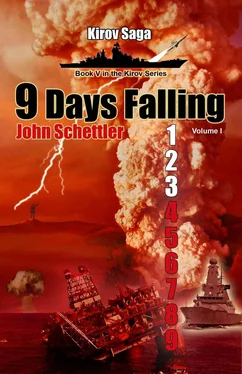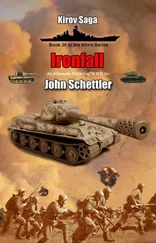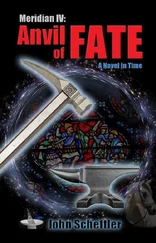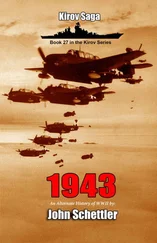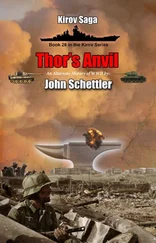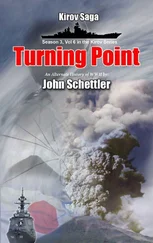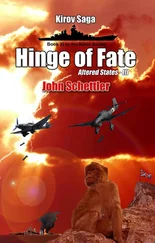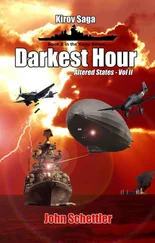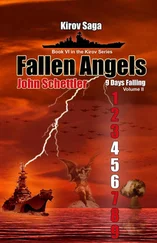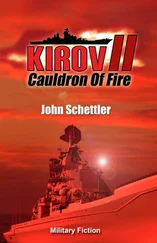Karpov expected this. Tanner would have to put something in the air. The only question was whether or not those planes would be chasing seagulls or Russian ships. “Is the battlegroup still heading north?”
“Yes, sir. They are about 200 kilometers south of the AEW line now, course 005 degrees. They can launch any time, and they’re definitely spotting now.”
Karpov did not like the sound of that. The American strike squadrons would have a combat radius of about 770 kilometers. Their standoff Harpoons could then fire at a range of 125 kilometers. They were already in strike range, some 600 kilometers to the south and his longest range cruise missile aboard Kirov was the P-900, which maxed out at 400 kilometers. He had two other fleet assets present with a longer reach. The Varyag was carrying the P-1000 Vulkan missile, built in the days when the design theory called for big missiles, with heavy warheads and long range. The newer inventory of supersonic missiles on Kirov today relied more on sheer speed and agility to defeat the enemy defenses, but Karpov now wished he had a big stick with a longer reach. Varyag was a powerful long range threat. The fleet carrier Admiral Kuznetsov also carried eight P-700 Shipwreck missiles with a 625 kilometer range.
If he wanted to be able to begin offensive operations he had to do it with those two ships or the limited strike wing aboard the Admiral Kuznetsov, or else take his surface action group south at high speed so Kirov could close the range. The two sides were closing on one another at about 25 to 30 knots each. This meant the range was diminishing by a hundred kilometers per hour. In another two hours he might get his flagship into missile range, but he had another option, though he was waiting on a signal from Fokino before he acted.
As for his adversary, the Americans had at least four strike squadrons on that carrier with at least twelve planes each. That could theoretically bring 48 planes with Harpoon anti-ship missiles, but the math wasn’t that simple. In WWII each strike plane of the Japanese carriers had the simple job of carrying a single torpedo or one or two dumb bombs to the target. Everything was different in modern warfare, because defeating the enemy electronics suite was also a necessary part of the attack. If you could jam or suppress their radars you could then inhibit the otherwise fearsome SAM missile defense modern ships were capable of projecting. Karpov knew the American planes would be arrayed with a wide range of assigned duties if an attack came in, and he had studied the tactics well. Know thine enemy…
AWACS coverage would be provided by the carrier itself and land based assets already in place on the AEW line. Two groups of four fighters would be equipped for target combat air patrol, (TARCAP) and fighter escort duty. At least one or two planes would be standoff jammers flying the FA-18G Growler, and two F/A-18E/Fs would be equipped for mid air refueling operations. Two groups of 4 strike aircraft each would be equipped for SEAD duty, the Suppression of Enemy Air Defenses. These would carry HARM anti-radiation missiles to seek out the Russian radars and hopefully get some hits. These twenty planes were just the strike asset support group.
The meat of the package would come in three groups of four F/A-18's equipped for long range ASUW, Anti Surface Warfare duty. They would carry at least two 360 gallon external fuel tanks at this range and a weapons load out of 2 x AIM-9 Sidewinders , 2 x AIM-120s and 4 x AGM-84 Harpoons . It was these last twelve planes he really had to worry about, and the 48 Harpoons they were carrying. So the math produced the same sum, though it got there by a different method. It was a deadly dance in the skies that required careful choreography. The difficulty was in coordinating the time on target for the Harpoons to be within seconds of the HARM attack on the his radar sets. It would not be easy in the heat of combat.
Karpov thought back to those early days in the North Atlantic where the British carriers would throw groups to ten or twenty old by-plane Swordfish and Fulmar fighters at him, and then again to the more sophisticated attacks mounted by the Japanese with waves upwards of ninety planes sent in from a full carrier division. Those attacks seemed so primitive and foolhardy to him now, and it was only Kirov’s dwindling SAM inventory that allowed any of those planes to have even the slightest chance of harming the Russian ship seriously.
The attack forming to his south, however, was another matter entirely, several orders of magnitude above the threat posed by Admiral Hara’s brave Japanese pilots of WWII. That said, Karpov did not think it would be enough. The support group and strike assets in the attack he imagined would probably use three of the four squadrons on this American carrier. They would need to hold back that fourth squadron for defensive CAP over their task force and other contingencies. While a potent threat, the Captain did not think the Americans would seriously hurt his task force with this single carrier. If Captain Tanner was a wise man he would wait for the Nimitz group and then coordinate a joint attack, double or nothing.
He did not underestimate the skill of his opponent, but what Karpov did not know was that Tanner was now constrained by the urgency carried in that last FLASH emergency message traffic he had received. The American Captain had orders to find, attack and sink the battlecruiser Kirov , and another way to double down on his strike package bid that day. The Nimitz was coming for backup, but CVBG Washington was the cop on the beat at the moment, and if Tanner was ready to rumble he could strike at once.
This was the inherent advantage the Americans possessed, thought Karpov, the option of the first blow. Well I have some bad news for them. That option is mine as well. We have other assets in theater just for this contingency.
Rodenko soon reported planes in the air over the US carrier group, and trouble heading north with bad intent. Then came a sudden, distant rumble, a vibration in the air, and all Karpov could think about was that first deep vibrato when Orel blew up in the North Atlantic and sent them all careening through time to 1941. He could see the wide-eyed looks from Nikolin and Pavlov over on navigation with that same thought in mind as well, but Rodenko was quick with his report.
“It’s that damn volcano again,” he said coolly. “Another eruption, and it looks like a big one this time.”
Karpov took his field glasses and observed the distant outline of Iturup Island behind them where the volcano named “the Demon” was awakening. The thought he had about it earlier came to mind again, and his eyes narrowed with a demonic expression of his own. He grinned to recall how he had described himself as the devil to the American Captain. Perhaps there was some mischief in the air with this restless mountain behind him that he could use to good advantage.
“Rodenko, what’s the prevailing wind direction right now?”
“Almost due south, sir.”
~ ~ ~
AboardCVBG Washington Captain Tanner had finished consultation with his CAG, the Carrier Air Group Commander, and was watching the last of the Diamondbacks take off to form up for the attack. The Dambusters were spotted and ready to join them in the number three hole. The Royal Maces were already aloft and he would hold his last squadron, the Eagles in the cleanup spot. Karpov’s math was a little off that day. All SEAD and support craft aside, he had anticipated twelve strike planes with four harpoons each in the core attack, but there would be twice that number. Tanner had thirty-six planes between the three squadrons and he was using them all. And his support group was going to turn over all escort and TARCAP duty to some friends arriving from nearby airfields on Japan.
Читать дальше
